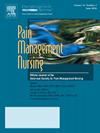Peripheral Percutaneous Electrical Nerve Stimulation for Neuropathies: A Systematic Review and Meta-analysis
IF 1.6
4区 医学
Q2 NURSING
引用次数: 0
Abstract
Objective
The main objective of this review is to demonstrate the use of Peripheral Percutaneous Electrical Nerve Stimulation (PENS), together with its most up-to-date protocols, for the treatment of neuropathies.
Design
We conducted a systematic search for randomised clinical trials evaluating the effectiveness of PENS on pain intensity, sleep quality, oral analgesic intake and depression in patients with neuropathic pain.
Data Sources
The search was performed in Pubmed, PEDro and Cochrane databases.
Analysis methods
The meta-analysis was conducted using RevMan 5.4 software. The mean difference was applied for variables with the same measurement scale, while the standardized mean difference was used for different scales. The inverse variance method was employed for statistical analysis, with heterogeneity assessed using the I² and Cochrane Q statistics.
Results
Four articles that met the search requirements were included. After qualitative and quantitative synthesis, the results obtained were an improvement in pain intensity (−3.57 [−4.01, −3.13]; p < .05) and sleep quality (2.48 [1.96, 3.00]; p < .05) and a reduction in medication intake (−2.37 [−4.26, −0.47]; p < .05) and depressive behaviours (−1.10 [−1.55, −0.66]; p < .05). The overall methodological quality was rated as moderate and the risk of bias as unclear.
Conclusions
The scientific evidence found is still limited for the use of PENS in neuropathies. However, this study suggests an encouraging future for the use of this therapy as a treatment tool in physiotherapy.
Nursing Practice Implications
PENS requires nurse education on electrode/needle placement and patient instruction, with documentation of key parameters. This review emphasizes the need for further research to establish standardized protocols and optimal application parameters for different neuropathic pain conditions.
外周经皮神经电刺激治疗神经病:系统综述与元分析》。
摘要本综述的主要目的是展示外周经皮神经电刺激(PENS)及其最新方案在治疗神经病变方面的应用:设计:我们对评估经皮神经电刺激对神经病理性疼痛患者的疼痛强度、睡眠质量、口服镇痛药摄入量和抑郁的有效性的随机临床试验进行了系统检索:数据来源:在 Pubmed、PEDro 和 Cochrane 数据库中进行检索:荟萃分析使用 RevMan 5.4 软件进行。对于测量尺度相同的变量采用平均差法,对于测量尺度不同的变量采用标准化平均差法。统计分析采用反方差法,异质性采用 I² 和 Cochrane Q 统计量进行评估:结果:共收录了四篇符合检索要求的文章。经过定性和定量综合,结果显示疼痛强度(-3.57 [-4.01, -3.13];P < .05)和睡眠质量(2.48 [1.96, 3.00];P < .05)有所改善,药物摄入量(-2.37 [-4.26, -0.47];P < .05)和抑郁行为(-1.10 [-1.55, -0.66];P < .05)有所减少。总体方法学质量被评为中等,偏倚风险不明确:结论:在神经病变中使用 PENS 的科学证据仍然有限。然而,这项研究表明,在物理治疗中使用这种疗法作为治疗工具的前景令人鼓舞:PENS 需要护士在电极/针头放置和患者指导方面接受教育,并记录关键参数。本综述强调了进一步研究的必要性,以便针对不同的神经病理性疼痛状况制定标准化方案和最佳应用参数。
本文章由计算机程序翻译,如有差异,请以英文原文为准。
求助全文
约1分钟内获得全文
求助全文
来源期刊

Pain Management Nursing
医学-护理
CiteScore
3.00
自引率
5.90%
发文量
187
审稿时长
>12 weeks
期刊介绍:
This peer-reviewed journal offers a unique focus on the realm of pain management as it applies to nursing. Original and review articles from experts in the field offer key insights in the areas of clinical practice, advocacy, education, administration, and research. Additional features include practice guidelines and pharmacology updates.
 求助内容:
求助内容: 应助结果提醒方式:
应助结果提醒方式:


